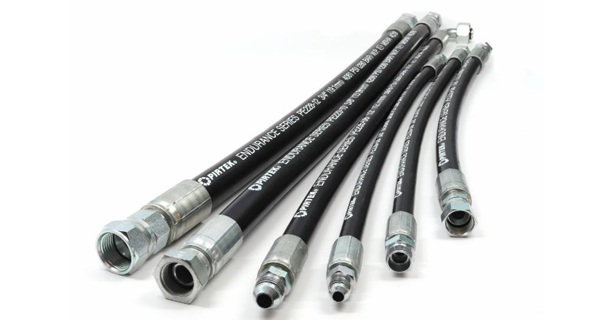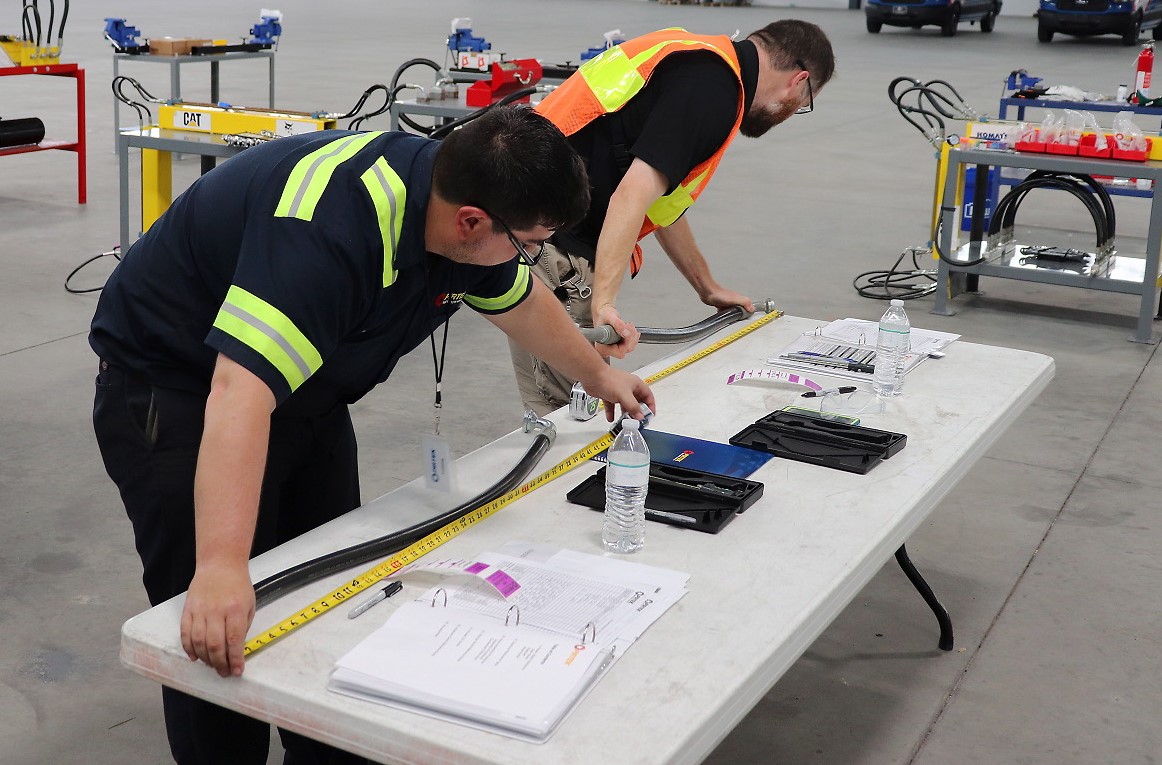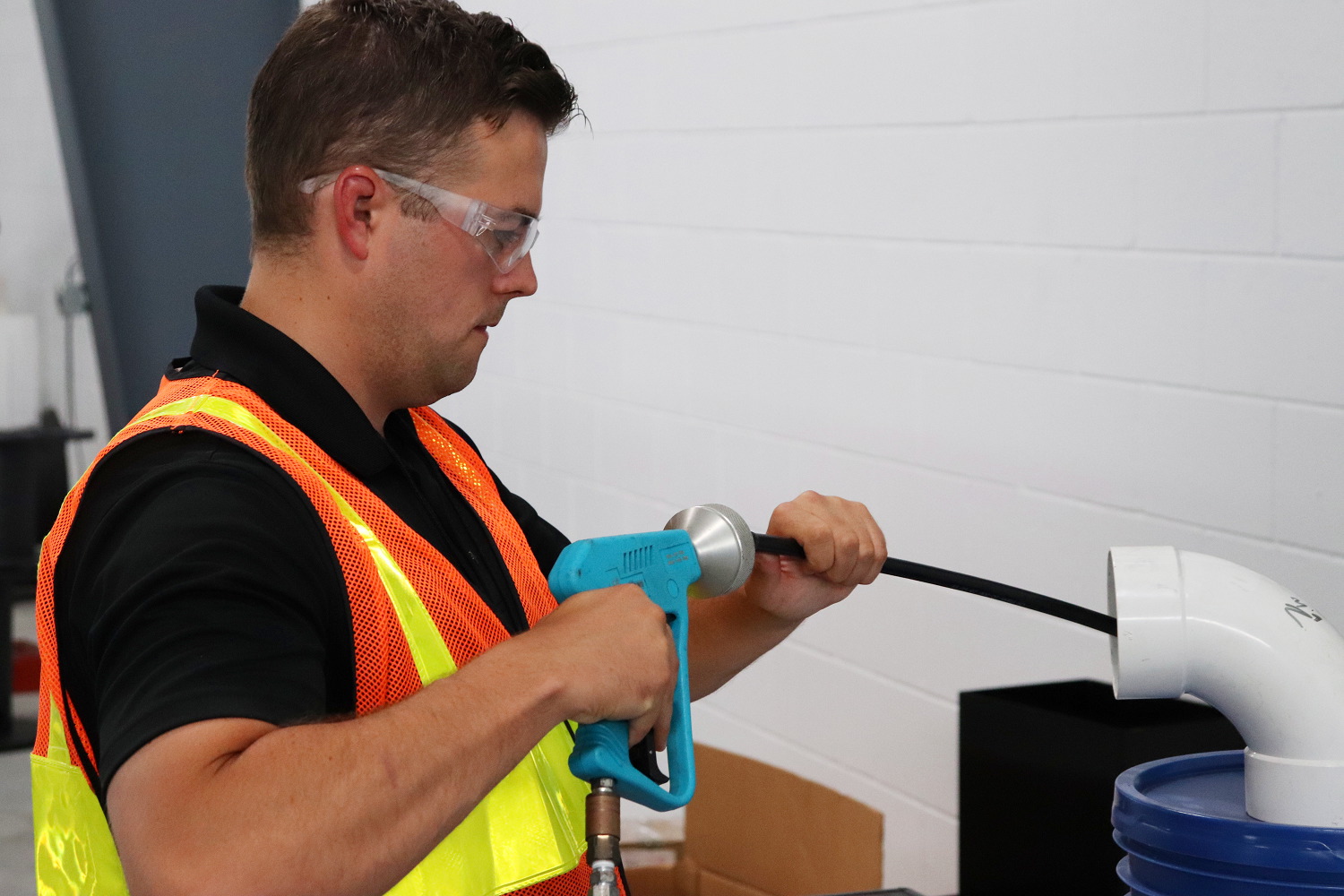By Mike Rutan, Product Development Manager, PIRTEK USA. Originally published in Fluid Power Journal November 2022 Issue
For essential businesses everywhere, equipment is their lifeline. If one piece isn’t working, it can put projects on hold and set your whole business back. Hydraulic hoses are a crucial equipment component in industries such as construction, engineering, manufacturing, agriculture, transportation, logistics, pharmaceuticals, rail, and automotive.
If something happens to a hydraulic hose, quick replacement is of the utmost importance. Luckily, there are preventative steps businesses can take to protect their equipment, operations, and company as a whole.
There are many reasons a hose fails. The most common one is simply old age. The life clock of a hydraulic hose starts ticking even before the hose is assembled, installed, and put into service. Like many products, hydraulic hoses have a “best before” date. As that date approaches, hoses become more susceptible to breakage. Environmental factors like temperature, humidity, and exposure to UV and ozone can alter the life expectancy of a hydraulic hose, as can storage methods. Additionally, some hoses are built to withstand extremely high temperatures, but when exposed to temperatures higher than what they’re made for, they can quickly become compromised.
Another reason hoses may fail is due to abrasions. Hoses that constantly rub against other machine parts compromise the outer cover, exposing the reinforcement layer to elements that can weaken the steel, reducing its ability to withstand pressures. Hoses sometimes come into contact with chemicals that can erode their structure.
How your hoses are secured can make a big difference when it comes to lifespan. Clamps often secure the hose in place, aid in proper flexion, and protect it from rubbing on adjacent parts. If clamps are missing or broken, it can drastically reduce the life expectancy of the hose.
Finally, many components break due to extreme amounts of pressure. Each hose is graded for how much pressure it can sustain. Even though hydraulic hoses have a 4:1 safety factor (burst pressure is four times the working pressure), significant pressure spikes can cause a hose to fail prematurely. If you install a hose that isn’t built to withstand the machine’s pressure requirements, it’s only a matter of time before you need to replace it.
Preventative maintenance
It has been said that an ounce of prevention is worth a pound of cure. This is never truer than when dealing with hydraulic and industrial equipment maintenance. In an environment with a high demand for employees and a short supply of people power, it is critical to maximize the efficiency of your human resources. Sending employees home or having employees reassigned to less productive work because of unplanned equipment downtime is just one of the many costs associated with hydraulic hose failures.
Running your systems without regularly checking and performing maintenance is risky. Think of your car. What would happen if you went a year or more without an oil change, tire rotation, or a scheduled inspection when the “check engine” light is on?
Prevention can also help you avoid other costs associated with unexpected equipment failures, including:
- Lost productivity potentially resulting in lost revenue.
- Environmental spill clean-up, contamination removal, and revitalization (such as replacing sod).
- Potential fines for late project completion, which are common in the construction industry.
- Damage to nearby sensitive equipment, such as computers and other technology.
- Damage to products from oil spraying onto assembly lines.
- Legal expenses if an employee is injured due to an equipment failure on a job site.
- Hydraulic hose failures can cause other failures in the system’s pumps or valves.
Inspecting the hydraulic hose before putting it into service is imperative. Often, covers on the equipment need to be removed to visually inspect the hoses hidden inside the machine. On skid steer loaders, the rollover protection system needs to be removed or raised regularly to access the hoses on the pump, valves, drive motors, and so on. I have occasionally raised the rollover protection system on an older piece of equipment only to see that I am the first person in over a decade to have done so.
On excavators, the drive motors to the tracks are behind plates. I have removed the plates and found the entire compartment completely packed with sand, dirt, silt, and years of sediment that corroded the fittings. Excavators are sometimes used for dredging ponds and waterways, and the water can be very corrosive when tracks are submerged.
Another preventative measure is knowing when to replace hoses. I have replaced multiple hoses on a piece of equipment because the customer declined my recommendation to replace those hoses on my initial service visit. Instead, he only wanted the failed hose replaced.
I have also replaced hoses on an interstate highway where the tow truck owner not only had to pay for the replacement of the failed hose but also for spill cleanup and remediation, which cost thousands of dollars.
The best way to ensure that a system will last its full lifespan is to take care of it. Some modern hydraulic hoses can last one million impulse cycles when managed correctly.
Protecting workers
One reason to keep up with the maintenance of your hydraulic hoses is to prevent work-related injuries. Your equipment is key to making your company a safe place to work, and the failure of hydraulic hoses can result in several hazardous scenarios.
For example, when fluid at high pressure exits through a pinhole in a hose, it can cause a fluid injection injury to an employee. Fluid can cut through clothing and skin, enter the body and potentially cause a dangerous reaction or infection. For hydraulic hoses operating at high temperatures, fluid leakage can cause severe burns.
Meanwhile, faulty hydraulic hoses can cover a surface in oil, causing the most common types of workplace injuries: slips and falls. Depending on the work environment, hydraulic fluid can be flammable or even explosive, enhancing the risk of fire if a hose fails.
Similarly, if a hose holding a mechanical load in the air fails, it can cause mechanical movement of the equipment, potentially resulting in serious injury to workers under or around the equipment.
Of course, if one part of a system fails, it can damage other components. If a hose failure is not discovered and mitigated right away, the whole machine can malfunction, posing a significant financial burden. You may also lose precious time waiting for new equipment to be delivered or installed.
Your business itself is also a machine. If your equipment is compromised, you’ll be forced to shut down operations until you can repair it. Just because emergency hose replacement is available around the clock doesn’t mean you can wait until the last minute to inspect your hydraulic hoses. Waiting will almost guarantee that your business may end up closed for repairs and leave your projects in a precarious position.
Not only can faulty hydraulic hoses be dangerous for your people and machinery, they can also pose a hazard to the environment. A compromised hose increases the potential for oil spills and other occurrences.
Keeping up with hose maintenance can prevent a company from damaging ecosystems and putting wildlife and fellow humans at risk. In today’s day and age, we have a lot of information about the greater impact of industrial activities on our environment. Hydraulic hose maintenance can help preserve the health and well-being of residents, wildlife, groundwater, and the area around the recovery site.
From a professional perspective, environmental damage also equates to poor social responsibility, bad press, fines, and major cleanup costs. Even if you have budgeted for these scenarios, avoiding them at all costs is better. If your company has experienced poor hydraulic hose maintenance that led to environmental hazards, this negative reputation can follow your business in future projects and jobs.
Maintaining hydraulic hoses
There are a few essential steps to keeping up with hose maintenance. First, look at the hose’s manufacturing date, which is typically printed on its outer cover. The age of the hose tells you if it needs to be inspected further.
Keep a record of when each hose is put into service. Hose assemblies have a predetermined life expectancy and should be replaced before their expected expiration.
Track when specific hoses are removed from service. This establishes a standard replacement interval for each machine, averting future hose failures. Finally, tagging hoses during installation helps signal when a hose needs replacement.
An easy way to tell if a hose needs replacement is by regular visual inspection. Look for things like oil leaks and improper hose routing. Look for loose, corroded, or damaged fittings, improperly matched components, brittleness, oil permeation, or color changes to the outer cover of each hose. Look for small physical changes, like poorly crimped ends, abrasions, nicks, cuts, blisters, or cracks.
Make sure hoses are not rubbing each other or surrounding objects that can damage the hose’s outer cover. Check whether they are twisted or in a bind. A 5° twist in a hydraulic hose can reduce life expectancy 70%, while a 7° twist reduces it up to 90%.
Next, look for missing or damaged clamps, sheaves, pullies, tie wraps, guards, or other vital parts. Hoses may need to be secured to prevent rubbing and allow for proper movement of the hose throughout the machine’s normal range of motion.
Lastly, make sure the hose is protected. Place a spring guard where hoses can get smashed by falling debris, a burst sleeve if hoses are near a machine operator, a nylon sleeve to prevent rubbing and exposure to UV light, and plastic wrap to prevent hoses from rubbing on surroundings endangering people working around hose ends.
Finding any of these “red flags” on hydraulic hoses requires action. Replace any hoses that show signs of damage, misuse, abuse, premature wear, or are past their expected service life.
Check the oil
Get in the habit of checking the hydraulic oil. If it’s discolored, milky, or foamy, it may be contaminated with water, air, or other substances. Contaminated oil can cause failures throughout a hydraulic system, including premature hose failures.
Perform regular hydraulic fluid analysis. Analyzing the fluid in a professional lab can prevent component failures. The hydraulic fluid is the lifeblood of the machine; ensure that it’s in good condition.
Finally, to ensure there are no leaks, test the equipment at its full operating pressure and normal operating temperature. Make sure no hoses are rubbing, twisting, or stretching beyond their limits throughout the machine’s normal range of motion.
Repairing hydraulic hoses is not an option. Only professionals should attempt to perform maintenance or replace hydraulic hoses to minimize health and safety risks.
Many workplace accidents, equipment failures, and hazardous environmental mishaps are preventable. Investing in hose maintenance significantly saves on future replacement costs and ensures a business continues running smoothly. Acknowledging your role in running an essential business, the last thing you need is a major, preventable disruption caused by equipment failure.




